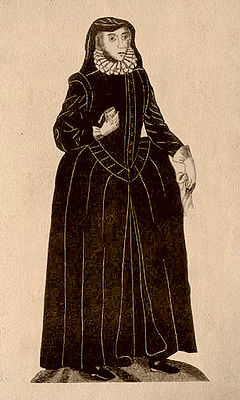
Anne Turner on her way to the gallows; source unclear, but from a contemporary print (wikimedia commons)
During Tudor times, huge starched collars called ruffs were all the rage. They must have been miserable to wear. Special elongated spoons had to be invented to allow ruff-wearers to eat. During the reign of James I (who succeeded Elizabeth in 1613), Mrs. Anne Turner, a widow and somewhat shady character on the fringe of respectability, invented a lovely yellow-tinted starch. She made herself famous among court ladies for her yellow-starched ruffs. A few years later, Anne was hanged for murder.
It’s a complicated and somewhat sordid tale, but here’s the upshot: a scheming couple wanted to get a certain lord by the name of Thomas Overbury out of the way. They managed to get him thrown into the Tower of London on trumped-up charges of treason against the king. Not content to see him imprisoned, the couple enlisted Mrs. Turner to carry out Overbury’s murder by slow poison. Arsenic and sublimate of mercury, procured by Mrs. Turner, were sprinkled on tasty-looking tarts and pies and delivered to the prisoner by a complicit servant, disguised as a guard. But Overbury didn’t die; he kept giving himself purgatives and enemas, which seemed to counteract the poison. So Mrs. Turner was told to prepare a poisoned enema. It contained a lethal dose of sublimate of mercury. This did the trick, and poor Overbury died a prolonged and agonizing death. His death was ruled accidental.
Two years later, public suspicions were aroused and investigations were made. Because they were friends and courtiers, the king pardoned the couple who had masterminded the murder. But Mrs. Turner and her lower-born accomplices were not so lucky. They were condemned to death.
As a somewhat bizarre detail in an already-bizarre story, the judge ordered Mrs. Turner to wear her yellow ruff to her execution. She duly arrived dressed in her finest gown, complete with rouged cheeks and stiffened yellow ruff, and was hanged. After that court ladies abruptly stopped wearing yellow ruffs.